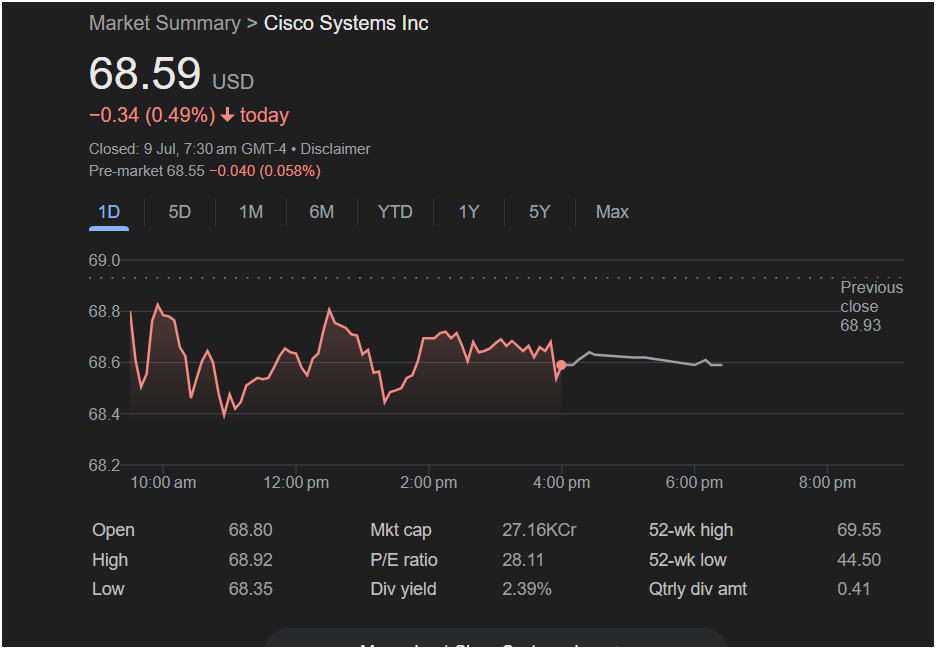Cisco Systems Falters Near 52-Week High, Slips as Investors Take Profits; Strong Dividend Yield Provides a Value-Oriented Cushion

SAN JOSE, CA — Shares of networking and cybersecurity giant Cisco Systems Inc. closed in negative territory on Tuesday, July 9th, experiencing a modest pullback as the stock encountered resistance near its 52-week peak. The established technology “blue-chip” ended the trading day at
0.34 or 0.49%.
The slight downward pressure appeared to be lingering into the next session, with pre-market indications showing the stock trading fractionally lower at $68.55, a further dip of 0.058%. The day’s trading action highlights the ongoing tug-of-war for a mature tech company like Cisco: the push for growth in a dynamic market versus the pull of its identity as a stable, value-oriented investment.
A Day of Contention: The Intraday Tug-of-War
The one-day trading chart for Cisco paints a picture of a stock that struggled to find its footing throughout the session. The day began with an open of
68.93.
In the opening minutes of trading, there was a brief attempt by buyers to push the stock positive. It rallied to its intraday high of $68.92, but critically, it failed to break above the previous day’s closing price. This failure at a key technical resistance level proved to be the high-water mark for the bulls, and sellers immediately seized control.
What followed was a sharp sell-off through the morning, with the stock tumbling to its session low of $68.35 just before noon. This low point, however, attracted value-conscious buyers, likely drawn in by the company’s fundamentals and dividend yield. The remainder of the day was characterized by choppy, range-bound trading. The stock made several attempts to recover its morning losses but was repeatedly met with selling pressure in the
68.80 range.
Ultimately, the stock was unable to mount a sustained comeback and closed near the lower third of its daily trading range. The after-hours trading, indicated by the faint grey line, showed a continuation of this listless drift, reinforcing the narrative of a stock in a period of consolidation.
The Bedrock of Value: Unpacking Cisco’s Financials
The financial metrics provided in the screenshot are essential to understanding Cisco’s investment profile, which differs significantly from the hyper-growth tech darlings.
-
Market Capitalization: Cisco’s market cap is listed as 27.16KCr. This notation, common in South Asia, translates to approximately $271.6 Billion. This substantial valuation solidifies Cisco’s status as a large-cap, blue-chip stalwart in the technology sector. While not in the multi-trillion-dollar league of AI-focused giants, this market cap reflects a massive, profitable, and deeply entrenched global enterprise.
-
Price-to-Earnings (P/E) Ratio: The P/E ratio stands at a reasonable 28.11. This valuation multiple suggests that the market expects steady, predictable earnings rather than explosive, speculative growth. It indicates that investors are paying a rational price for the company’s current and near-term projected profits. A P/E in this range is often attractive to value and “growth at a reasonable price” (GARP) investors who are wary of the sky-high valuations seen elsewhere in the tech sector.
-
The Dividend: A Pillar of the Investment Thesis
The most distinguishing feature of Cisco’s financial profile is its dividend. The company offers a robust Dividend Yield of 2.39%, supported by a Quarterly Dividend Amount of $0.41 per share. This translates into a reliable annual cash payment of $1.64 for every share owned. In an environment of market volatility, this substantial and consistent dividend provides a powerful incentive for long-term investors. It offers a tangible return, acts as a potential cushion against price declines, and signals management’s confidence in the company’s enduring financial strength and cash-flow generation. For many, the dividend is the primary reason to own Cisco stock.
Context is Key: The 52-Week Journey
The day’s negative performance must be viewed within the context of its strong run over the past year. The data shows a 52-week low of $44.50 and a 52-week high of $69.55.
The closing price of $68.59 places the stock less than a dollar, or about 1.4%, away from its 52-week high. Having rallied more than 54% from its lows, it is entirely natural for a stock to encounter profit-taking and consolidation as it approaches such a significant peak. The day’s sell-off can be interpreted less as a sign of fundamental weakness and more as a logical pause in a strong, long-term uptrend.
Outlook: Navigating the Transition
Cisco is a company in transition. While it remains a dominant force in its legacy networking hardware business (routers and switches), its future growth depends on its successful pivot towards higher-margin software, subscription services, and cybersecurity. Its recent high-profile acquisition of Splunk is a cornerstone of this strategy, aimed at making Cisco a leader in security and observability.
Investors will be watching upcoming earnings reports for evidence that this strategic shift is translating into accelerating revenue growth and expanding margins. The performance of its new AI-focused networking platforms and its ability to integrate Splunk successfully will be critical catalysts for the stock.
In conclusion, Tuesday’s trading session for Cisco was a classic example of a mature market leader pausing for breath near a major milestone. The negative close reflects short-term profit-taking, but the company’s solid valuation, significant dividend yield, and strategic pivot toward future growth areas provide a compelling long-term narrative. For investors seeking a blend of stability, income, and potential growth in the tech sector, Cisco remains a cornerstone portfolio holding.






